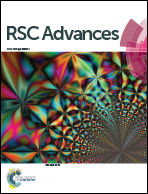Integrated microfluidic device for the spherical hydrogel pH sensor fabrication†
Abstract
In this work, hydrogel photonic crystal beads with inverse opal structure are generated on a well-controlled microfluidic chip device. An online droplet drying method and templating technique are integrated into the producing process. This process results in the silica nanoparticles in the droplets self-assembled into spherical photonic crystals with narrow stop bands and identical structural colours, which is the ideal template for fabricating inverse opal hydrogel beads. The effects of acrylic acid (AA) concentration, water dosage and buffer pH on the equilibrium swelling of inverse opal hydrogel are discussed. In the concentration of AA (3%) and water (31%), the inverse opal hydrogel beads show wide sensing range and rapid response (less than 30 s) to pH variation. Overall, the inverse opal hydrogels as pH sensors show homogeneous structural colour changes due to the spherical 3D structure. The present characterization of quite mechanically robust and good reproducibility for the spherical pH sensor may have promise application in advanced optical devices.


 Please wait while we load your content...
Please wait while we load your content...